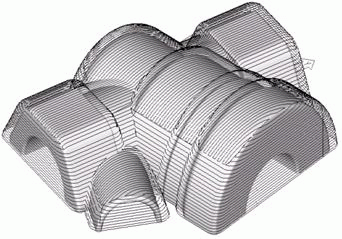Complex operation (waterline-plane)

The complex operation consists of two toolpaths: plane and waterline. The plane toolpath machines only areas with the slope angle less than the Split slope angle while the waterline toolpath machines areas where the surface slope angle is greater than the Split slope angle. By default the split slope angle is set to 45 degrees. This strategy ensures that shallow areas are machined with the plane toolpath, and steep areas are machined with the waterline toolpath. The benefits of such an approach are optimal cutting conditions, consistent scallop height and reduced machining time.
A model being machined for the complex operation is assigned by a set of solid bodies, surfaces and meshed objects. For every geometrical object or a group of objects, an additional stock, which during machining will be added to the main stock of the operation, can be defined.
If a workpiece and a restricting model are not defined, then the system performs machining of the entire available surface of the model being machined. Otherwise only those surface areas will be machined, which lie within the workpiece and outside the restricting model.
The workpiece can be assigned as a cube, cylinder, a mould with stock or prismatic form, as residual material after machining by previous operations, and also as a free-form geometrical model, consisting of solid bodies, surfaces, meshes and prisms whose bases are projections of closed curves. In the restricting model, solid bodies, surfaces and meshes which are required to be controlled during machining, and also machining areas and restricted areas, defined by projections of closed curves can be defined.
The work passes of the operation lie in two parallel vertical planes. The planes of different operations are perpendicular to each another. The positions of the planes are defined by the angle between these planes and the Z-axis. The step between the planes of neighboring work passes can be either fixed or calculated according to the defined height of the scallop.
When using a local coordinate system or a rotary head, the position of the model being machined will not change, the tool rotation axis is parallel to the Z axis of the local coordinate system, and all work passes are located in planes that are perpendicular to the horizontal plane of the local coordinate system.
It is also possible to restrict machining from entering areas of the restricting model and areas of edge rounding in the resulting toolpath.
Joining of the work passes into a single toolpath can be performed going downwards or upwards. Transition between neighboring work passes can be performed on the surface, using retract and approach moves or via the safe plane.
See also:
Operations for the 3-axes milling